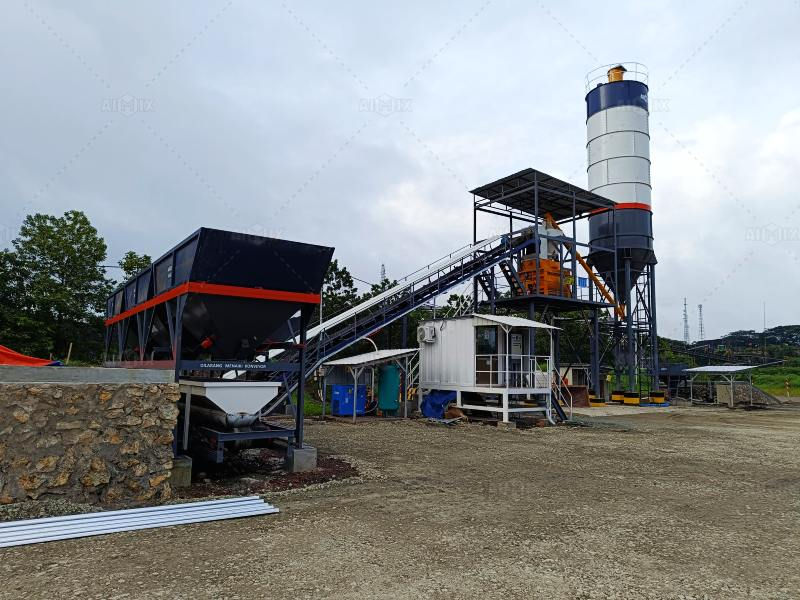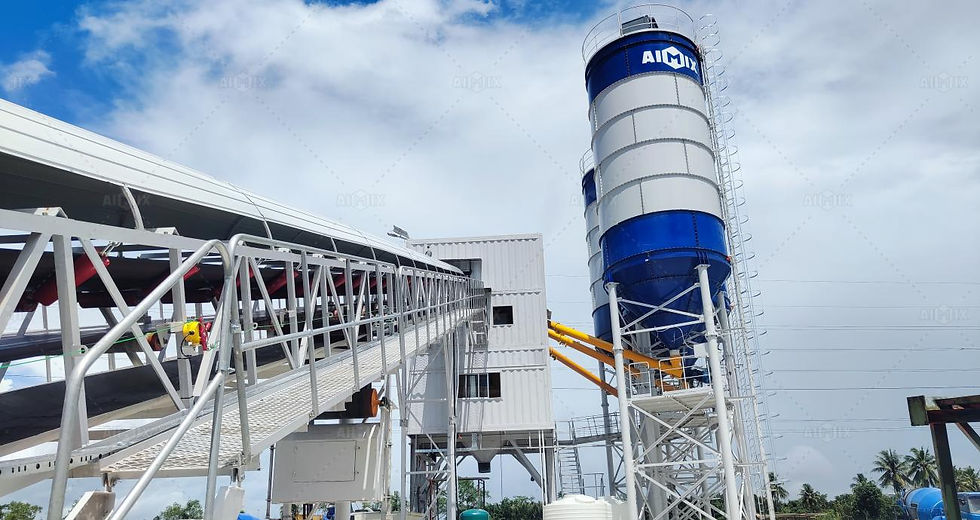How Location and Logistics Affect the Cost of Concrete Batching Plant
- aimixglobal5
- Aug 28, 2025
- 4 min read
When investing in a concrete batching plant, contractors often focus on purchase price, capacity, and brand reputation. However, one of the most overlooked aspects is the influence of location and logistics on overall costs. From transportation expenses to availability of raw materials and local regulations, the site where the plant is installed can significantly affect long-term operating efficiency and profitability.
This article explores how location and logistics play a crucial role in determining the cost of concrete batching plant ownership and how contractors can plan better to reduce hidden expenses.

1. The Connection Between Location and Plant Costs
A concrete mixer plant is not just a piece of machinery—it is part of a larger supply chain involving cement, aggregates, water, admixtures, labor, and electricity. The location where the plant is set up directly affects access to these resources and therefore influences overall cost.
Urban Locations: Setting up a batching plant near urban centers provides easy access to raw materials and labor but often comes with higher land costs, stricter regulations, and congestion-related delays.
Rural or Remote Locations: In areas with lower land prices, initial investment may be smaller, but challenges arise in terms of transporting raw materials and finished concrete.
Balancing these trade-offs is essential for contractors planning long-term operations.
2. Transportation of Raw Materials
One of the largest cost factors influenced by location is the logistics of raw materials.
Aggregates and Sand: If the plant is located close to quarries or suppliers, transportation costs for aggregates and sand decrease significantly. Otherwise, long-distance hauling increases both fuel consumption and delivery time.
Cement Supply: Cement is bulky and sensitive to moisture. A batching plant near cement production facilities or reliable distributors reduces transport costs and ensures consistent supply.
Water Availability: Since water is a vital ingredient in concrete production, plants in areas with scarce water resources may incur additional costs for sourcing and transporting water.
Efficient sourcing of raw materials can reduce per-cubic-meter production costs, making location a key driver of affordability.
3. Transportation of Finished Concrete
The logistics of delivering ready-mix concrete to job sites also heavily impacts the cost of concrete batching plant operations.
Distance to Project Sites: Concrete has a limited workable time after mixing. Plants located far from job sites risk delays and rejected loads, leading to wastage and higher costs.
Transit Mixer Fleet: The further the distance, the larger the fleet of trucks required to ensure timely delivery. This increases both capital investment and ongoing fuel and maintenance expenses.
Traffic Conditions: In congested urban areas, slow traffic may demand more mixers to maintain delivery schedules, indirectly raising operating costs.
For this reason, many contractors strategically set up their concrete mixer plant close to major projects to minimize transport costs and reduce delays.

4. Infrastructure and Accessibility
The infrastructure around the batching plant site also plays a critical role in long-term cost.
Road Connectivity: Plants in locations with good highway access benefit from faster, cheaper transportation of both raw materials and finished concrete.
Power Supply: Reliable electricity is essential for batching plants. Areas with unstable grids may require investment in backup generators, increasing operational costs.
Site Preparation: Remote sites often need significant civil work to level land, create access roads, or establish drainage systems. These site preparation costs can be substantial.
In contrast, accessible industrial zones may have higher land prices but reduce infrastructure-related overheads.
5. Regulatory and Environmental Costs
Location also determines the level of regulatory compliance and associated costs.
Urban Regulations: Plants in city limits face stricter noise, dust, and environmental regulations. Meeting these requirements may require additional dust collectors, enclosures, or noise-control systems.
Rural Regulations: While often less strict, rural or ecologically sensitive zones may impose environmental fees or restrictions on water usage, impacting costs.
Permits and Approvals: In some regions, acquiring permits to establish a batching plant can involve significant time and money, which should be factored into the investment.
Contractors must evaluate the regulatory landscape of potential locations to avoid unexpected compliance costs.
6. Labor and Workforce Availability
Labor costs and availability vary by location, further influencing the cost structure.
Urban Areas: Skilled labor is easier to find but wage levels are higher.
Rural Areas: Labor costs may be lower, but training expenses may increase due to limited availability of skilled workers.
For automated batching plants, fewer workers are required, but technicians must be readily available to maintain complex systems. The ability to source and retain the right workforce is essential for smooth operation.
7. Long-Term Logistics Planning
Forward-thinking contractors recognize that the true cost of concrete batching plant ownership extends beyond initial purchase. Effective long-term logistics planning can reduce operational costs by:
Establishing plants close to long-term projects like highways or dams.
Using portable or mobile concrete mixer plants for projects spread across multiple locations.
Partnering with local suppliers to secure stable raw material supply.
Investing in GPS-enabled fleet management to optimize mixer routes and reduce fuel use.
Such strategies improve efficiency and minimize hidden costs associated with poor location choices.

Conclusion
The decision of where to set up a concrete mixer plant is just as critical as the decision of which model to buy. Location impacts raw material supply, delivery costs, infrastructure needs, regulatory compliance, and workforce availability. Poor planning can turn an affordable batching plant into a costly liability, while smart site selection can maximize efficiency and profitability.
By carefully analyzing location and logistics factors, contractors can make informed choices that reduce both the short-term and long-term cost of concrete batching plant ownership. Ultimately, the right location doesn’t just cut costs—it ensures consistent concrete quality, timely project delivery, and a stronger competitive edge in the construction market.







Comments